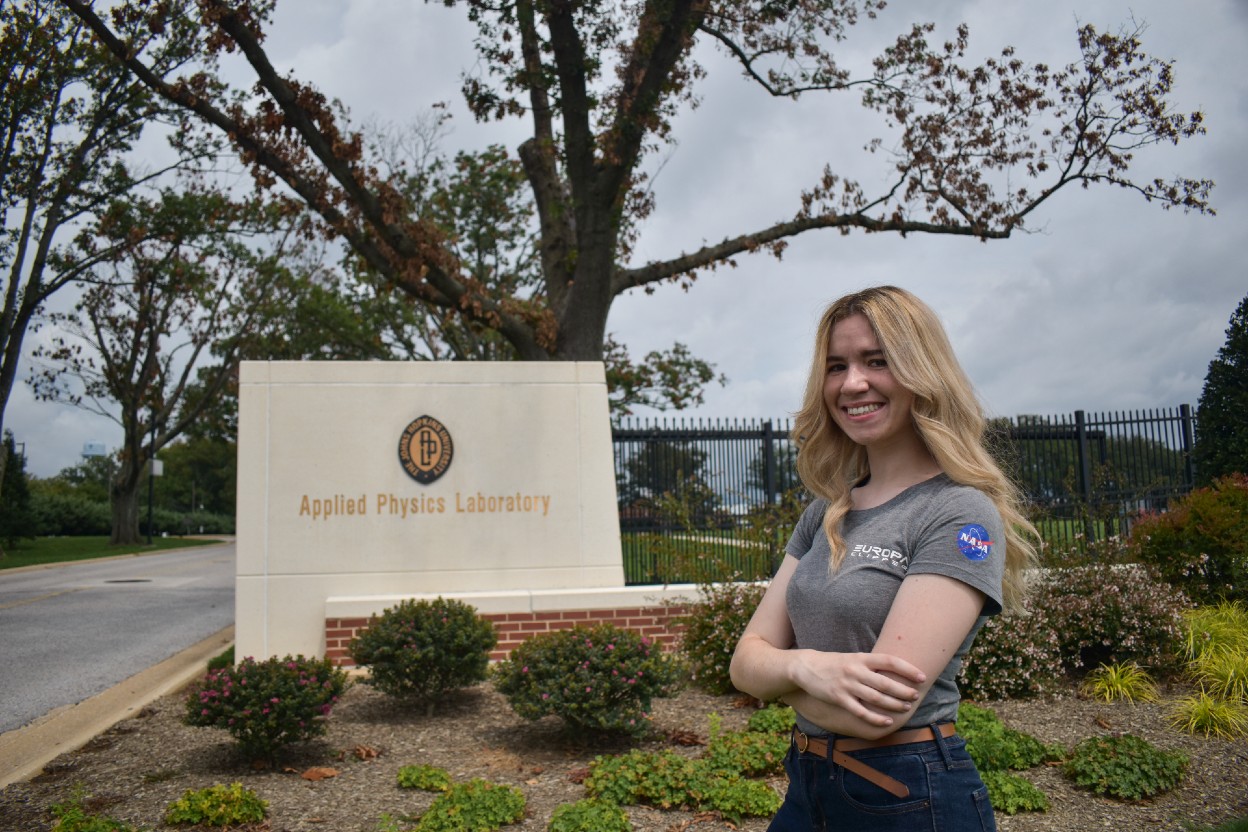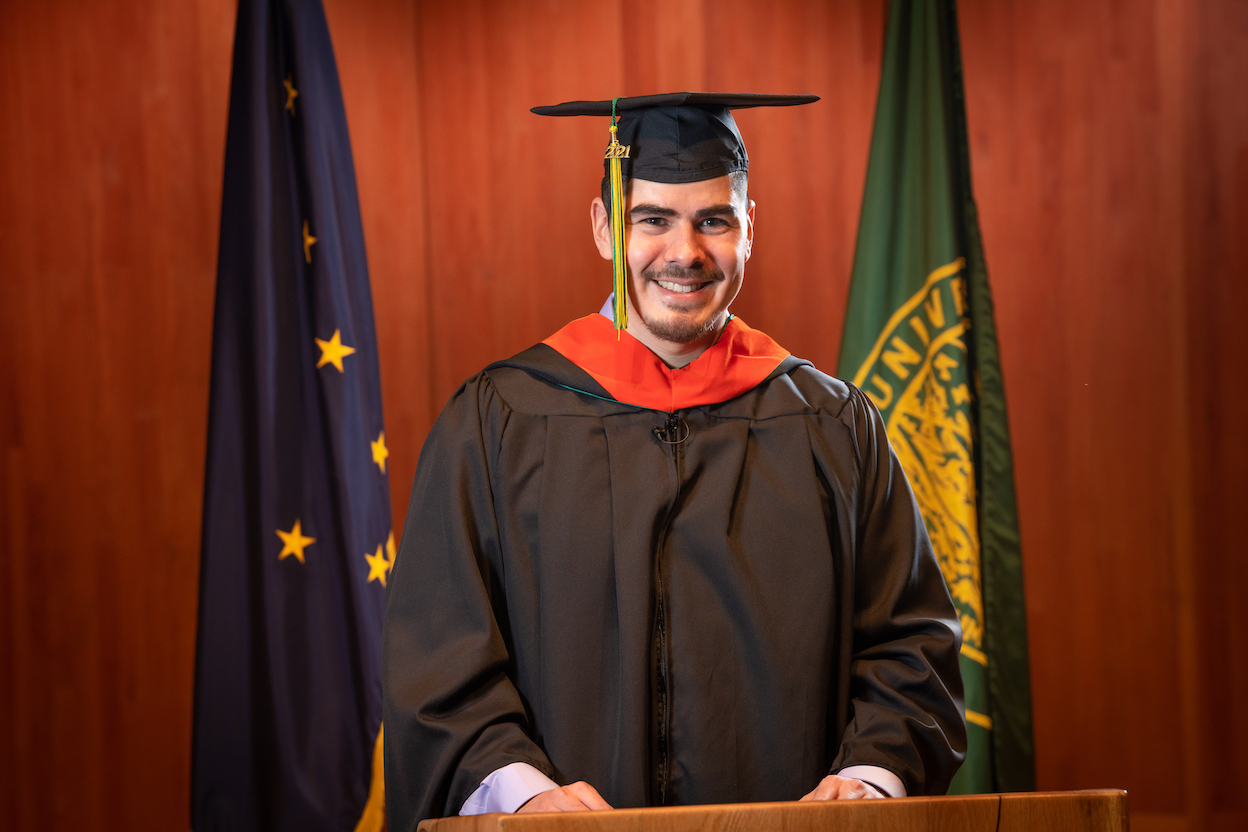Geological sciences grad joins team supporting NASA Europa mission
by Matt Jardin |

Applied geological sciences master’s graduate Charlie Detelich vividly remembers the day she was offered a position at the Johns Hopkins University Applied Physics Laboratory supporting the NASA Europa Clipper mission planned to launch in October 2024. That day, she was still processing the rejections she received to several Ph.D. programs.
“I was wallowing around my house and all of a sudden I got this magical email that said the best opportunity of your life has just been offered to you. Do you want it?” said Detelich. “My entire life I’ve wanted to work on NASA missions. It felt like a dream come true. All this hard work finally paid off. It was so surreal and exciting.”
As part of the laboratory’s space exploration team, Detelich will primarily work on predevelopment for the imaging system attached to the orbital spacecraft. Put another way, she’ll be calibrating the settings on the cameras that are programmed to take high-resolution photographs of the moon Europa from low orbit.
Additionally, Detelich will be helping the instrumentation team’s overall logistics and coordination, as well as maintaining and improving the mission’s website.
“It's a surreal place because you're working with some of the best scientists in the world on things that actually go to space and explore the universe,” said Detelich. “There's this energy where everyone knows that what everybody is doing is important. You can be the intern or the head of the lab and you're still considered a vital part of the team. I'm really excited to be someplace that has that energy and to contribute to that effort.”
Europa is of great interest to NASA and the general scientific community. It potentially holds secrets about life in the universe due to the vast subsurface ocean protected by the moon’s outer icy shell.
The third mission to the smallest of Jupiter’s four Galilean moons, Europa Clipper will build off of what was learned from the Voyager spacecraft in the '80s and the Galileo spacecraft in the '90s with vastly superior technology.
After a three-year journey, Europa Clipper will not only take more detailed photos using the advanced imaging system Detelich is assisting with, but will also fly closer than any spacecraft before and directly through geysers to collect samples. The orbiter is also equipped with a radar that is powerful enough to more clearly peer through the moon’s surface, and a magnetometer to see how Jupiter's magnetic field interacts with Europa.
“On Earth, where we have water, we have life. So Europa Clipper is essentially looking for the ingredients of life,” said Detelich. “We might be able to find out if there's life beyond Earth. We could learn how life started on Earth, because that's something we don't really know. So the mission is contributing to human understanding of our place in the universe.”
While Europa and Jupiter are what is currently in Detelich’s orbit, what launched her on her current trajectory lies further. Always knowing she wanted to study space, she was originally an aerospace engineering major at North Carolina State University until she happened to catch a news conference in 2015 about the New Horizons space probe to Pluto.
“They were showing pictures of mountains made of ice on Pluto that are as high as the Rockies and the head of the mission said they had all this data coming in and they need more planetary geologists to understand it all,” said Detelich. “That was the first time I had ever heard the term planetary geology. That was what made me think, there are people who make their careers off of studying the planets themselves and why they look the way they do?”
Researching her new focus on planetary geology, Detelich came across the work of Simon Kattenhorn, Ph.D. One of the world’s leading scientists studying icy satellites, Kattenhorn also serves as professor of geological sciences at UAA, putting him in the perfect position to pass along his expertise to students. For Detelich, the opportunity to learn from one of the top minds in her field was the driving force that brought her to UAA to pursue her graduate degree.
“It has been a pleasure and a privilege to serve as Charlie’s graduate research mentor,” said Kattenhorn. “Charlie has grown to be a gifted planetary mapper and brings a level of dedication and professionalism to her work that really stands out. Her contributions to my NASA-funded project at UAA have been invaluable and I look forward to publishing our collaborative work in the near future.”
Detelich’s position with the Johns Hopkins University Applied Physics Laboratory will come to a close in August 2022. Afterward, she plans to pick up right where she left off before receiving that initial magical email. This time around, she hopes to use her newly acquired experience to enter a Ph.D. program in planetary science and eventually, planning, executing and leading her own NASA missions.
“Perseverance has been my biggest takeaway from my time at UAA,” said Detelich. “Dr. Kattenhorn really molded me into being the best possible scientist I can be and taught me to continue to push forward. And the geology department itself did a great job of helping me learn how to apply knowledge.”
 "Geological sciences grad joins team supporting NASA Europa mission" is licensed under a Creative Commons Attribution-NonCommercial 4.0 International License.
"Geological sciences grad joins team supporting NASA Europa mission" is licensed under a Creative Commons Attribution-NonCommercial 4.0 International License.













